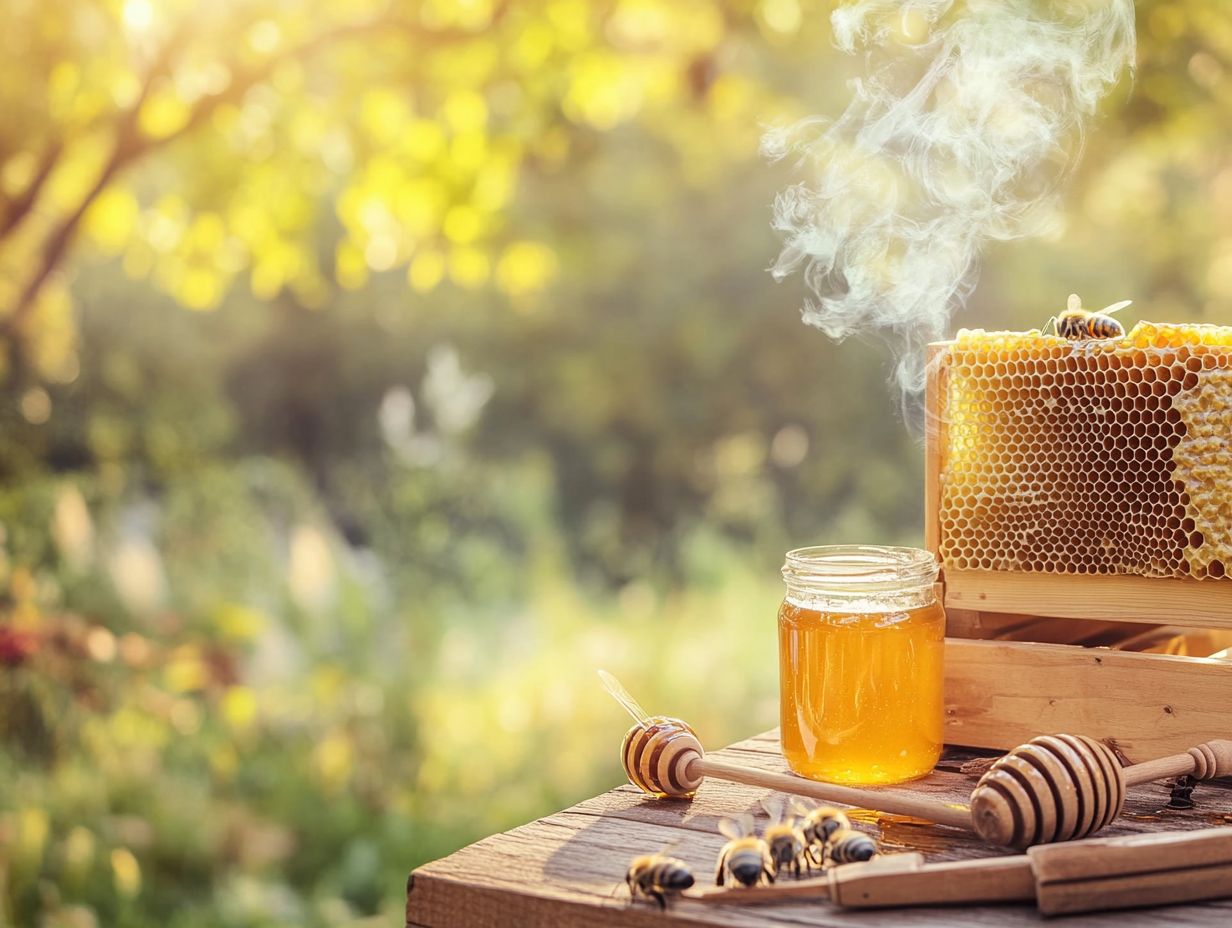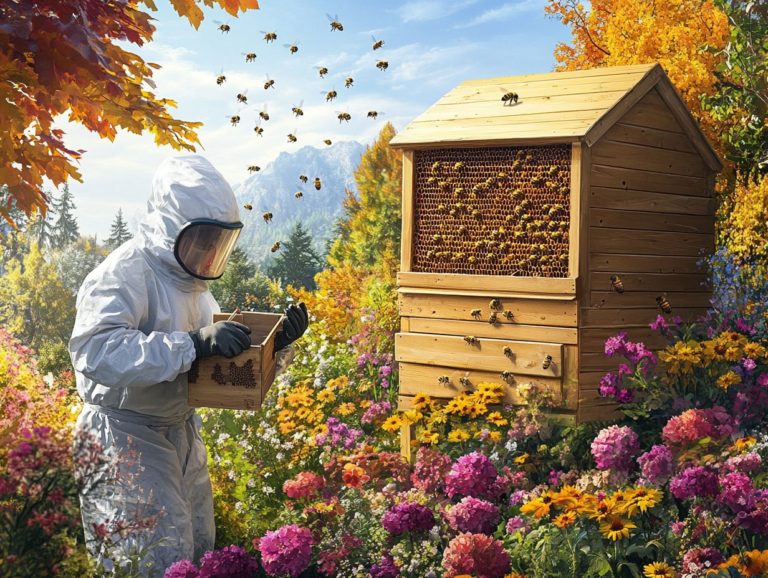The Role of Beekeeping Equipment in Honey Quality
Beekeeping is a fascinating blend of art and science. The right equipment plays a crucial role in determining the quality of honey you produce.
Using the right tools boosts the efficiency of your beekeeping practices. It also ensures your bees thrive in a healthy environment. Each piece of equipment, from hive components to protective gear, is vital for the well-being of your colony and the purity of the honey.
You’ll discover how different types of beekeeping equipment impact honey quality. We will cover what factors to consider when selecting the best tools for your beekeeping setup.
Get ready to gather essential tips on using and maintaining your beekeeping gear. This will help ensure the honey you harvest reaches its highest quality.
Contents
- Key Takeaways:
- Unlocking the Secret: How Equipment Shapes Your Honey’s Quality!
- Types of Beekeeping Equipment
- What to Look for in Beekeeping Equipment for Honey Quality?
- How to Properly Use and Maintain Beekeeping Equipment?
- Frequently Asked Questions
- What is the role of beekeeping equipment in honey quality?
- What equipment is essential for maintaining honey quality?
- How does the type of beehive affect honey quality?
- Why is clean and well-maintained equipment important for honey production?
- Can equipment affect the flavor of honey?
- How often should beekeeping equipment be replaced?
Key Takeaways:
- Beekeeping equipment plays a crucial role in the quality of honey produced.
- When choosing beekeeping equipment, look for durability, proper sizing, and ease of use and maintenance.
- Proper use and maintenance of beekeeping equipment is essential for producing high-quality honey.
Unlocking the Secret: How Equipment Shapes Your Honey’s Quality!
Beekeeping equipment is vital in shaping the quality of honey you produce. It directly impacts the health and productivity of your bee colonies.
Essential tools such as hives, frames, and excluders help you manage your beekeeping setup effectively. This ensures optimal honey production.
The right equipment safeguards your bees and enhances the quality of the honey you harvest. Experienced beekeepers know that the success of your honey crop relies on both the bees and your ability to create a well-managed environment using appropriate tools.
How Does Beekeeping Equipment Affect the Quality of Honey?
The quality of honey you produce is influenced by the type and condition of your beekeeping equipment. This impacts various factors, including bee health, hive management, and honey extraction techniques.
When your hives are well-maintained, they provide a safe environment for the bees. This allows them to thrive and produce nectar that’s simply superior.
Your choice of equipment—such as the types of hives and tools for monitoring bee populations—plays a pivotal role in keeping your bees healthy and productive.
Effective management practices, like regular inspections and proper feeding, enhance the conditions for your bees. By focusing on these critical elements, you can significantly elevate the quality of your honey. This ensures that your product meets market standards and delivers the rich flavors and health benefits that consumers crave.
Types of Beekeeping Equipment
Understanding the various types of beekeeping equipment is crucial for you as a beekeeper. Each item plays a distinct role in fostering a healthy environment for your bees and ensuring a bountiful honey harvest.
From hive components that offer shelter and structure to protective gear that shields you during inspections, having the right tools is essential. Additionally, several accessories assist in managing your apiary effectively, enhancing the overall health of your bee colonies.
Familiarizing yourself with these tools will help you create an optimal environment where your bees can thrive. This will allow your honey production to reach its fullest potential.
Start equipping yourself today for the sweetest honey!
1. Hive Components
Hive components are vital for beekeeping. They greatly affect the productivity and health of your bee colonies.
These include frames, foundations, and excluders. Each plays a key role in managing your bees and producing honey.
Frames provide structural integrity for the hive. They allow bees to build honeycomb and store honey effectively.
Foundations guide bees in drawing out wax. This is essential for raising brood and storing nectar.
Excluders keep the queen from laying eggs in the honey super areas. This ensures your honey is pure and free from brood.
Using these components promotes better organization in the hive. They help maintain healthy colonies and maximize your honey yield.
Investing in quality hive components is key to successful beekeeping.
2. Protective Gear
Protective gear is essential for beekeepers. It ensures safety while managing your bee colonies and harvesting honey.
This gear includes items designed to shield your body from stings. Bee suits provide full-body coverage and reduce sting risks.
Gloves protect your hands but still allow the dexterity needed for hive inspections and honey extraction.
Veils guard your face and neck from curious bees. Each piece of protective equipment creates a secure working environment.
3. Tools and Accessories
Various tools and accessories can enhance your beekeeping efficiency. They provide crucial support for managing colonies and maximizing honey production.
Smokers calm your bees during inspections. This allows for safer and more effective work.
Hive tools help pry apart frames and scrape excess wax. This keeps each colony healthy and productive.
Feeders supplement bee nutrition, especially during lean times. This promotes stronger colonies.
These tools form the backbone of effective apiary management. They help optimize honey yield while ensuring the well-being of your bees.
What to Look for in Beekeeping Equipment for Honey Quality?
Choosing the right beekeeping equipment is essential. Consider factors that influence honey quality, like durability, proper sizing, and ease of use.
High-quality materials ensure your equipment lasts. They also protect the health of your bee colonies.
Getting the sizing right is crucial. This ensures all components fit well, reducing stress on the bees.
User-friendly tools make management tasks easier. This allows you to focus on maximizing honey production.
Understanding these elements can elevate your success in beekeeping.
1. Durability and Quality of Materials
Choosing durable materials for your beekeeping equipment is crucial. It ensures long-lasting use and keeps your honey quality high.
Take wood, for instance. It’s a classic choice for hive construction, especially types like pine and cedar. These woods are valued for their insulating features, which help maintain the temperature inside the hive. This stability significantly contributes to the well-being of your bees and helps preserve the flavor and nutritional value of your honey.
On the flip side, plastics are gaining popularity due to their lightweight nature and resistance to rot, making them convenient and durable. However, you must consider how these materials interact with your bees and the environment. Certain plastics can leach chemicals that might affect honey quality or bee health.
Understanding these material properties is essential for beekeepers who want to optimize both the longevity of their equipment and the quality of their honey harvests.
2. Proper Sizing and Fit
Proper sizing and fit of your beekeeping equipment are vital for effectively managing your bee colonies and ensuring optimal honey production.
Selecting equipment, like frames and hives, that aligns with your colonies’ needs promotes their health and well-being. It also facilitates smoother inspections. A well-fitted hive minimizes stress on the bees, allowing them to thrive and engage in their natural behaviors.
With easy access to properly sized frames, your routine checks become quicker and less invasive. This fosters a more productive environment. Thoughtful selection of these essential tools can significantly influence both your honey yield and the vitality of your colonies.
3. Ease of Use and Maintenance
The ease of use and maintenance of your beekeeping equipment is key to the efficiency and effectiveness of honey production.
User-friendly tools like automatic uncappers and easy-to-clean extractors save you time and reduce errors during honey extraction.
Regular maintenance practices, such as routinely checking hive conditions and ensuring proper insulation, support your bee colonies’ health.
Investing in high-quality bee feeders and beginner-friendly hive kits creates a manageable setup that fosters optimal conditions for bee activity. This leads to higher honey yields and enhanced flavor profiles, ultimately resulting in a superior product that meets market demands.
How to Properly Use and Maintain Beekeeping Equipment?
Proper use and maintenance of your beekeeping equipment are essential for the longevity of your tools and the health of your bee colonies. Both directly influence honey production.
Regularly cleaning and sanitizing your hives and tools significantly reduces the risk of diseases. Consistent inspections help you identify potential issues before they escalate. Mastering the right storage techniques keeps your equipment in top shape for when you need it.
These practices are vital for beekeepers who aspire to maximize the quality of their honey crop.
1. Cleaning and Sanitizing
Cleaning and sanitizing your beekeeping equipment are essential steps in protecting the health of your bee colonies and ensuring the production of high-quality honey.
Regular maintenance of your hives, tools, and protective gear boosts your overall efficiency and significantly reduces the risk of disease transmission. After using your smokers, clean them thoroughly to prevent mold buildup that can harm the bees’ immune system.
Replacing worn-out gloves and ensuring your storage containers are airtight minimizes exposure to harmful pests.
By establishing a consistent cleaning routine, you not only protect your colonies but also create an environment that fosters productivity and longevity among your bees.
2. Regular Inspections and Repairs
Regularly inspecting and repairing your beekeeping equipment is essential for managing your bees and producing quality honey. These checks help you spot wear and tear, preventing minor issues from becoming major problems.
Addressing small repairs promptly maintains a stable and healthy environment for your colonies. This ensures your equipment remains safe and functional, supporting the health of your bees and boosting productivity.
A proactive approach to maintenance helps your apiary thrive. Focus on nurturing your bees instead of facing preventable setbacks.
3. Proper Storage
Proper storage of your beekeeping equipment enhances its longevity and efficiency. It ensures your tools are ready for use whenever you need them.
Using smart organization techniques creates an efficient workspace. This minimizes clutter and allows quick access to essential items during inspections or honey extraction.
Utilizing labeled containers for different tools helps maintain order. Keeping equipment elevated off the ground protects it from moisture and pests.
Ensure storage areas are sealed tightly to deter unwanted insects and rodents. This safeguards your valuable gear from damage.
Regular maintenance checks are crucial for prolonging your equipment’s life. Early detection of wear helps you address issues promptly, keeping your tools in top shape for all your beekeeping endeavors.
Frequently Asked Questions
What is the role of beekeeping equipment in honey quality?
Beekeeping equipment plays a key role in maintaining honey quality. It helps in the proper extraction, storage, and handling of honey, ensuring it remains pure and free from contaminants.
What equipment is essential for maintaining honey quality?
Essential equipment includes beehives, honey extractors, uncapping knives, strainers, buckets, and storage containers. These tools are necessary for honey extraction, filtering, and storage.
How does the type of beehive affect honey quality?
The type of beehive can greatly impact honey quality. Traditional wooden hives produce high-quality honey, while modern plastic hives might not maintain purity as well.
Why is clean and well-maintained equipment important for honey production?
Clean and well-maintained equipment prevents contamination and preserves honey quality. Dirty or damaged tools can introduce impurities into honey, affecting its taste.
Can equipment affect the flavor of honey?
Yes, beekeeping equipment can affect honey’s flavor. Plastic tools might leave a plastic taste, while wooden equipment enhances the natural flavors.
How often should beekeeping equipment be replaced?
Replace beekeeping equipment regularly to maintain honey quality. Wooden tools last several years, but plastic ones may need more frequent replacements. Regularly inspect and replace any damaged or worn equipment.










